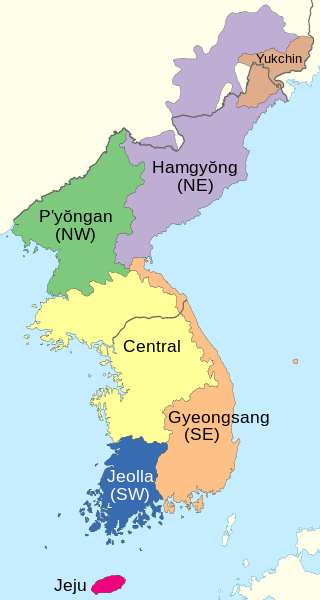Gwangju usually refers to Gwangju Metropolitan City in South Korea:
It may also refer to:
- Gwangju, Gyeonggi, a small city in Gyeonggi-do, South Korea
- Guangzhou, China, in Korean contexts
Gwangju usually refers to Gwangju Metropolitan City in South Korea:
It may also refer to:
Korea's provinces have been the primary administrative division of Korea since the mid Goryeo dynasty in the early 11th century, and were preceded by provincial-level divisions dating back to Unified Silla, in the late 7th century.

Gyeonggi-do is the most populous province in South Korea. Its name, Gyeonggi, means "京 and 畿 ". Thus, Gyeonggi-do can be translated as "Seoul and the surrounding areas of Seoul". Seoul, the nation's largest city and capital, is in the heart of the area but has been separately administered as a provincial-level special city since 1946. Incheon, the nation's third-largest city, is on the coast of the province and has been similarly administered as a provincial-level metropolitan city since 1981. The three jurisdictions are collectively referred to as Sudogwon and cover 11,730 km2 (4,530 sq mi), with a combined population of over 26 million - amounting to over half (50.25%) of the entire population of South Korea at the 2020 Census.

Muan County (Muan-gun) is a county in South Jeolla Province (Jeollanam-do), South Korea. In 2005, Muan County became the capital of Jeollanam-do following the transfer of the provincial office from its previous location, Gwangju to the village of Namak in Muan. Muan International Airport was opened here, and will eventually replace the airports in Gwangju and Mokpo.

A number of Korean dialects are spoken on the Korean Peninsula. The peninsula is very mountainous and each dialect's "territory" corresponds closely to the natural boundaries between different geographical regions of Korea. Most of the dialects are named for one of the traditional Eight Provinces of Korea. Two are sufficiently distinct from the others to be considered separate languages, the Jeju and the Yukjin languages.

Gwangju is a city in Gyeonggi Province, South Korea, a suburb southeast of Seoul. The city is not to be confused with the much larger Gwangju Metropolitan City, former capital of South Jeolla Province, South Korea.
Gwangju City may refer to:
Hanam is a city in Gyeonggi Province, South Korea. Formerly a part of Gwangju County, it was designated a city in 1989. The ancient Baekje capital of Hanam Wiryeseong may have been located there.
Pyeong-dong may refer to one of the dong of cities in South Korea:
Bulgoksan is the name of two mountains in South Korea:
東區, 东区, or 東区, all literally meaning East District, may refer to the following:
河南 is the Chinese name for Henan province in China.
Shinsegae is a South Korean department store franchise, along with several other businesses, headquartered in Seoul, South Korea. The firm is an affiliate of Shinsegae Group, South Korea's leading retail chaebol, and one of the big three department store firms in Korea, along with Lotte and Hyundai Department Store. Its flagship store in Centum City, Busan, was the world's largest department store at 3,163,000 square feet (293,900 m2), surpassing Macy's flagship Herald Square in New York City in 2009.
Guangzhou is a city in China's Guangdong Province.
Yong is a family name used in Korea, as well as a character in some Korean given names. It may also mean sun in some cases. As a family name, it may also be spelled Ryong in Korea. It is of Sino-Korean origin.
Geomdansan may refer to:
Sinchon-dong may refer to:
An Institute of Science is an educational institution that imparts higher education in various scientific disciplines.
Mo (모) is an uncommon Korean surname, It originated from either of two hanja, which are also used respectively to write the Chinese surnames Móu or Máo. The 2000 South Korean census found a total of 19,834 people and 6,110 households with these surnames. The surname is spelled Mo in all standard methods of romanizing the Korean language. In a study by the National Institute of the Korean Language based on 2007 application data for South Korean passports, all the applicants spelled this surname as Mo. The alternative spelling Moh is occasionally seen.
The Gwangju City Ballet was founded in Gwangju, South Korea in 1976. As one of only five professional ballet companies in South Korea, the company performs a repertoire which includes many full-length narrative ballets such as Swan Lake, The Nutcracker, The Sleeping Beauty, La Sylphide, Don Quixote, Coppelia, and so on. The company has continuously been supported by Gwangju Metropolitan City, the sixth-largest city in South Korea.